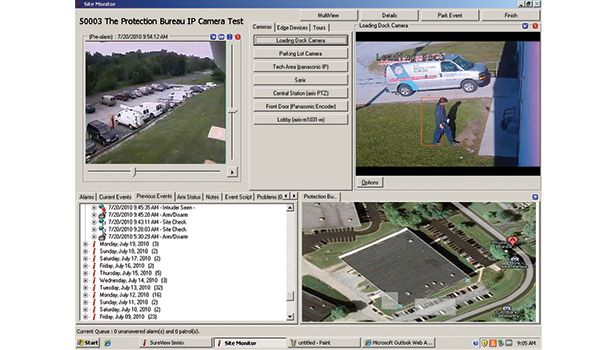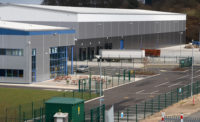Perimeter security is no longer a tool unique to military facilities, power plants, oil refineries and other high-risk locations. Over the past decade, advancements in technology and changes in cost have transformed perimeter security and expanded the clientele to include organizations that had never considered exterior protection in the past, such as hospitals, schools, retail spaces, rail yards, and other urban and remote locations.
While traditional alarm systems, contacts, motion detectors and physical barriers continue to play a role in perimeter detection, analytics and thermal imaging have changed the landscape of this security segment. Evolution and advancements have made video analytics available to a larger customer base for exterior security. The cost of analytics has declined, and the increased sophistication of the technology allows analytics to be used in place of fencing, other physical barriers, and traditional motion sensors for certain applications.
Video Analytics Play a More Powerful Role
“We are seeing the industry change, and part of that is driven by customers wanting the earliest possible potential threat detection,” shares Bill Savage, president of Security Control Systems Inc., Houston. “We are seeing all kinds of customers wanting perimeter security — they don’t have to have a large space. It is as much to do with early detection as it is size. Video analytics has been a game changer in this space and allows us to now apply perimeter detection even where there might not be a well-defined perimeter.”
Savage adds that this ability to use video surveillance and analytics to apply a virtual fence around a perimeter in place of a physical fence has opened up this market segment to all customers. Analytics can be used to alert security staff to early detection of a person walking within a certain boundary of a campus. Suspicious activity, such as loitering or running, can be flagged.
“In the old days it was beams and long-range motion detection, and some applications still call for that; but we are seeing a big shift to video analytics and thermal cameras for monitoring perimeters,” says Mike Painter, president of AlphaCorp. Inc., West Valley, Utah. Painter says that while the use of analytics and thermal imaging has steadily increased, the focus now is on simple applications, such as license-plate recognition, people counting, and elemental behavioral patterns. “Many of our customers are using basic analytics to analyze their markets in addition to security. It gives the customer more information,” Painter adds.
With the help of a knowledgeable integrator, analytics can be programmed to reliably ignore all of the false positives that used to come along with being utilized in outdoor environments, including blowing leaves, stirring animals, and other non-event scenarios.
For example, Matthew Ladd, president of The Protection Bureau, Exton, Pa., recalled a recent video surveillance and analytics roof installation for a retail location. In this case, car lights flashing from below and birds flying and landing on the roof were triggering false responses from the analytics technology upon installation. It was imperative that the integrator “teach” the analytics what to avoid so that the false alarms would be minimized, while at the same time legitimate alarm responses would be maximized. “Installation and setup takes longer with analytics, because it has to learn its environment, but once it’s up and running, it’s worth it,” Ladd explains.
According to Ladd, the benefit of tying in a video clip with an alarm event makes analytics an alternative to fence detection systems, contact sensors and motion sensors — all while offering a higher level of detection than in the past. “Analytics detect the threat and video allows the client to see if the alarm is legitimate and dispatch accordingly,” Ladd describes.
Thermal Imaging Changes the Scene
The technology advancements and cost reductions of analytics are not the only changes in perimeter security over the last decade. As infrared technology has become more advanced and more affordable as well, what once was a technology for an elite few, is now increasingly available and increasingly popular for customers of all price points. This is contributing to the growth in perimeter security and enabling more clients to implement advanced perimeter security as a part of their protection plans. Together, thermal imaging and analytics complement each other well and can meet all or many potential needs of the perimeter security market.
“We have seen a big increase in opportunities for infrared technology for perimeter applications. The price of the cameras has come down so much that the technology is no longer limited to critical applications. The system performance has improved greatly as well,” says Bill Hogan, president of D/A Central, Oak Park, Mich.
Part of that increase in popularity, according to Hogan, is that infrared cameras have longer range reads than in the past. Shorter range reads meant that customers experienced decreased accuracy, while requiring more cameras, making them cost-prohibitive in many cases. When working together, thermal imagery greatly improves the accuracy of analytics, allowing the algorithms to be certain of what the camera is seeing and better distinguish between a false alarm and a potential security breach.
Solar & Wireless Open Doors
Other technologies that have had a hand in changing the face of perimeter security include wireless communication and solar power. While neither technology has moved at the pace that video surveillance has in perimeter security installations, both technologies have played roles in changing perimeter security by offering answers to lack of power or cost-prohibition of trenching for hardwired copper and traditional wired systems.
Though solar power remains a specialty, need-based power source, its availability lets integrators address the perimeter security needs of unmanned, unpowered, extremely remote locations such as waterways and pumping stations.
“We are frequently using solar power with wireless technology for surveillance, intrusion and even two-way voice intercoms for perimeter applications,” describes Savage. “The technology allows these systems to be deployed over a very large footprint, while giving the customer a high degree of technology.”
Wireless installation, while not the dominating choice over running copper wire for perimeter security applications yet, is picking up pace and becoming a cheaper, more reliable option. “We are definitely seeing more wireless, but unfortunately it is not 100 percent there yet,” says Painter. “Wireless is where we would all like to be, but we still need some advancements before it becomes the standard.”
For the integrator, wireless installations are faster and easier to install on the front end than trenching for hardwired installations, but also require a great deal of education and training on the back end in order to be familiar with the technology and work with today’s sophisticated clients and IT staff.
“One of the toughest obstacles right now for the integrator is keeping up with technology,” says Richard Green, COO of Firstline Security, Anaheim, Calif. “Integration companies need to have IT expertise on board, as well as strong engineering and installation teams that are technology savvy, as well. Having product knowledge has become one of the biggest requirements.”
All of these technology changes have enabled perimeter security technology to be accessible to a more mainstream market than ever before. Customers that once only focused on internal security in their facilities are now considering increasing security on the perimeter by adding video surveillance outside of their facilities. Not only has this market segment become more widespread; but the perimeter security products of today are more advanced and more reliable than their predecessors. This gives experienced integrators the opportunity to offer an extra level of protection for customers of all sizes and in all industries.







